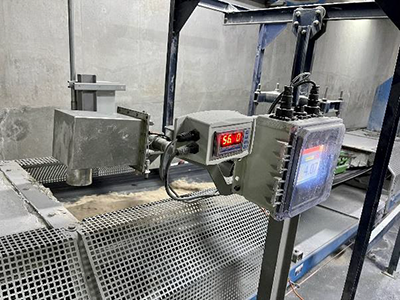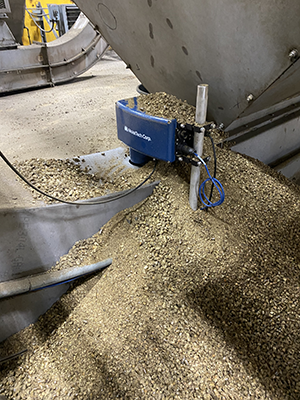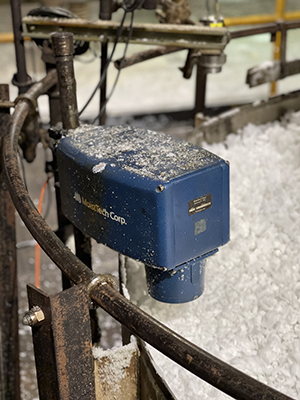
NIR Efficiency: Decrease human error with automated moisture measurement process systems
Mike Edwards
Features automation MoistTech NIR
Reducing front-end expenses and increasing quality and efficiency has always been a top priority for producers, highlighting the need for companies to thoroughly evaluate their current methods of reducing waste — wasted efforts, wasted energy, and wasted product.
Evaluating and implementing lean manufacturing principles assists in eliminating waste and improving overall plant production. With the implementation of moisture control systems, manufacturing plants can save a large amount of money in a short amount of time.
When considering the many challenges that plant operators are tasked with, moisture control plays a large role. Moisture content can affect product quality and equipment function, making it a crucial focus point in proactive avoidance of quality control issues. Dryer effectiveness is critical, as dryers consume a large amount of energy during operation. The implementation of moisture measurement before and after the dryer provides immediate control over the temperature and operational efficiency.
Moisture measurement and control sensors are in countless applications all over the world, saving manufacturers time and money by quickly detecting the variable manufacturing process, allowing corrections to be made in real time. Near-infrared (NIR) technology is best suited for instant online, offline and laboratory moisture instrumentation. Controlling moisture levels in powdered and granular applications production is a critical process during various stages of production, as the product can easily become too wet or dry, causing immediate production and quality issues.
Ideally, a moisture control system should be able to accurately detect moisture at different stages of the manufacturing process, be easy to maintain and be tough enough to withstand the harsh, abrasive nature of the raw materials and production environment. The installation of an NIR moisture detection device prevents out-of-specification product due to undesirable moisture levels, allowing the facility to fine tune the set-up to make sure a more consistent, higher quality product is produced – ultimately improving the bottom line. In other words, clients save money and time, and prevent negative results due to inconsistencies and human error.
 Over-drying a product can result in a dusty environment that can lead to a fire or dust explosion. As such, greater plant safety is achieved with a proper moisture measurement system and cost savings are enhanced. Dryer overuse results in overpaying on energy costs. By implementing a moisture detection process, producers can monitor 100% of their product quality instantly and consistently. Additionally, active adjustments can continuously be made to the process, optimizing the outcome.
Over-drying a product can result in a dusty environment that can lead to a fire or dust explosion. As such, greater plant safety is achieved with a proper moisture measurement system and cost savings are enhanced. Dryer overuse results in overpaying on energy costs. By implementing a moisture detection process, producers can monitor 100% of their product quality instantly and consistently. Additionally, active adjustments can continuously be made to the process, optimizing the outcome.
Preventing airborne dust and controlling the weight of the ash residue can be controlled by reading the moisture levels during processing. Data collection and analysis during the production process helps to determine the characteristics of the material prior to final processing, which provides process efficiency and optimization. Regular measurement of moisture in powdered and granular product manufacturing lines remains necessary for drying control, which reduces treatment costs.
NIR spectroscopy and imaging are fast and non-destructive analytical techniques that provide chemical and physical information of virtually any matrix. NIR can tell us things about a product in a similar way to visible light. When light hits a product, it will interact in various ways – transmitted light will pass through the product; backscattered light will reflect from the product; and some light will be absorbed into the product, which is the key to NIR analysis. Other common technologies experience issues such as constant recalibration and height interference, resulting in drifting over time and less reflective light energy. The user is there provided with more of an estimated guess, rather than accurate data.
NIR moisture control technology helps provide high-level equipment to manufacturing facilities in a multitude of applications. A ratio-based measurement with prime beam eliminates sensitivity to distance; improves stability and accuracy; and provides a non-drifting design. These features allow for extremely accurate measurements with high sensitivity. NIR technology is specific and stands out among other options because it is non-destructive, never contacts the product and provides instant, repeatable results.
 Optimizing the manufacturing process to include a moisture measurement and control system improves product quality and production efficiency and reduces the amount of dust and build-up created. Small variations in moisture content can result in clumping, affecting the quality and consistencies in the production; absence of moisture can result in excess dust. Non-contact moisture detection can provide real-time accurate data to help line personnel to properly control and eliminate common issues.
Optimizing the manufacturing process to include a moisture measurement and control system improves product quality and production efficiency and reduces the amount of dust and build-up created. Small variations in moisture content can result in clumping, affecting the quality and consistencies in the production; absence of moisture can result in excess dust. Non-contact moisture detection can provide real-time accurate data to help line personnel to properly control and eliminate common issues.
The ability to reduce waste and keep the production line moving is essential to plant operators. Moisture measurement and control plays a large role in the process and catching out of tolerance readings as quickly as possible on the line allows for increased plant efficiency and product quality.
Real-time process control with moisture detection provides true product data that can be used to improve operation efficiency. This reduces wasted effort and materials, and decreases the frequency of downtime, manual intervention, and defective goods. Increased plant efficiency, lower energy costs, higher accuracy, instant return on investment (ROI) and low to zero maintenance are just a handful of benefits seen when implementing a moisture control system.
Conclusion
In summary, there are a multitude of benefits for manufacturers with a moisture control system suited for their application, including:
- Reduced dryer usage and energy costs.
- Proper control of the infeed and dryer exit.
- Better quality and consistency of final product.
- Dust and fire elimination.
- Reduced purchase costs from water weight.
- Reduced amount of wear and tear on equipment from ash and dust build-up.
- Prevention of blockages on conveyor.
By mounting a sensor several inches above the conveyor and/or after the dryer, the process can be continuously monitored, and moisture content can be controlled either manually or automatically during production. Another reason for moisture detection with the process is that dust from the product creates and environment prone to fires due to the dry conditions. The sensors are specifically designed to ensure accuracy and repeatability. Additionally, there is no need to regulate temperature control, making them easy to use.
Manufacturers can experience immediate adjustments to their process based on real-time measurements, as the sensor reads and records hundreds of data points per second. Immediate changes can be made to the production line directly through the programmable logic controller (PLC) needed, to stop extra waste and maintain the effective movement of production lines. Additionally, costly downtime and excessive waste is avoided by catching any out-of-tolerance readings as quickly as possible. Manufacturers can connect the sensors to a computer network or production laptop for complete software control of the production line, creating a closed loop process.
This white paper article was contributed by MoistTech Corp.
Print this page